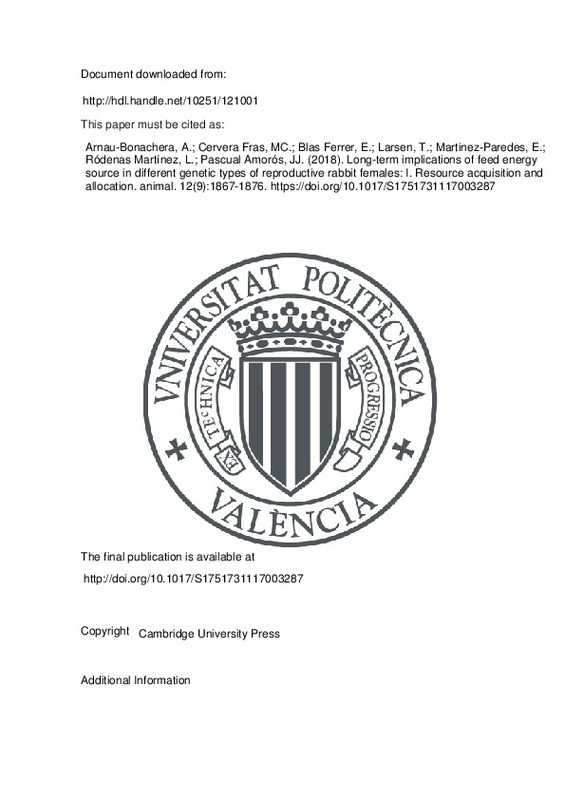JavaScript is disabled for your browser. Some features of this site may not work without it.
Buscar en RiuNet
Listar
Mi cuenta
Estadísticas
Ayuda RiuNet
Admin. UPV
Long-term implications of feed energy source in different genetic types of reproductive rabbit females: I. Resource acquisition and allocation
Mostrar el registro sencillo del ítem
Ficheros en el ítem
| dc.contributor.author | Arnau-Bonachera, Alberto
|
es_ES |
| dc.contributor.author | Cervera Fras, Mª Concepción
|
es_ES |
| dc.contributor.author | Blas Ferrer, Enrique
|
es_ES |
| dc.contributor.author | Larsen, Torben
|
es_ES |
| dc.contributor.author | Martinez-Paredes, Eugenio
|
es_ES |
| dc.contributor.author | Ródenas Martínez, Luis
|
es_ES |
| dc.contributor.author | Pascual Amorós, Juan José
|
es_ES |
| dc.date.accessioned | 2019-05-23T20:02:36Z | |
| dc.date.available | 2019-05-23T20:02:36Z | |
| dc.date.issued | 2018 | es_ES |
| dc.identifier.issn | 1751-7311 | es_ES |
| dc.identifier.uri | http://hdl.handle.net/10251/121001 | |
| dc.description.abstract | [EN] To achieve functional but also productive females, we hypothesised that it is possible to modulate acquisition and allocation of animals from different genetic types by varying the main energy source of the diet. To test this hypothesis, we used 203 rabbit females belonging to three genetic types: H (n=66), a maternal line characterised by hyper-prolificacy; LP (n=67), a maternal line characterised by functional hyper-longevity; R (n=79), a paternal line characterised by growth rate. Females were fed with two isoenergetic and isoprotein diets differing in energy source: animal fat (AF) enhancing milk yield; cereal starch (CS) promoting body reserves recovery. Feed intake, weight, perirenal fat thickness (PFT), milk yield and blood traits were controlled during five consecutive reproductive cycles (RCs). Females fed with CS presented higher PFT (+0.2 mm, P<0.05) and those fed AF had higher milk yield (+11.7%, P<0.05). However, the effect of energy source varied with the genetic type and time. For example, R females presented a decrease in PFT at late lactation (-4.3%; P<0.05) significantly higher than that observed for H and LP lines (on av. -0.1%; P>0.05), particularly for those fed with AF. Moreover, LP females fed with AF progressively increased PFT across the RC, whereas those fed with CS increased PFT during early lactation (+7.3%; P<0.05), but partially mobilised it during late lactation (-2.8%; P<0.05). Independently of the diet offered, LP females reached weaning with similar PFT. H females fed with either of the two diets followed a similar trajectory throughout the RC. For milk yield, the effect of energy source was almost constant during the whole experiment, except for the first RC of females from the maternal lines (H and LP). These females yielded +34.1% (P<0.05) when fed with CS during this period. Results from this work indicate that the resource acquisition capacity and allocation pattern of rabbit females is different for each genetic type. Moreover, it seems that by varying the main energy source of the diet it is possible to modulate acquisition and allocation of resources of the different genetic types. However, the response of each one depends on its priorities over time. | es_ES |
| dc.description.sponsorship | The authors thank Juan Carlos Moreno for his technical support. The grant for Alberto Arnau from the Ministry of Economy and Finance (BES-2012-052345) is also gratefully acknowledged. This study was supported by the Interministerial Commission for Science and Technology (CICYT) of the Spanish Government (AGL2014-53405-C2-1-P). | es_ES |
| dc.language | Inglés | es_ES |
| dc.publisher | Cambridge University Press | es_ES |
| dc.relation.ispartof | animal | es_ES |
| dc.rights | Reserva de todos los derechos | es_ES |
| dc.subject | Strategy | es_ES |
| dc.subject | Energy partitioning | es_ES |
| dc.subject | Life trajectory | es_ES |
| dc.subject | Animal fat | es_ES |
| dc.subject | Cereal starch | es_ES |
| dc.subject.classification | NUTRICION Y BROMATOLOGIA | es_ES |
| dc.subject.classification | PRODUCCION ANIMAL | es_ES |
| dc.title | Long-term implications of feed energy source in different genetic types of reproductive rabbit females: I. Resource acquisition and allocation | es_ES |
| dc.type | Artículo | es_ES |
| dc.identifier.doi | 10.1017/S1751731117003287 | es_ES |
| dc.relation.projectID | info:eu-repo/grantAgreement/MINECO//AGL2014-53405-C2-1-P/ES/MEJORA GENETICA DEL CONEJO DE CARNE:RESPUESTA A LA SELECCION Y SU EFECTO SOBRE LA REPRODUCCION, ALIMENTACION Y SALUD UTILIZANDO UNA POBLACION CONTROL CRIOCONSERVADA/ | es_ES |
| dc.relation.projectID | info:eu-repo/grantAgreement/MINECO//BES-2012-052345/ES/BES-2012-052345/ | es_ES |
| dc.rights.accessRights | Abierto | es_ES |
| dc.contributor.affiliation | Universitat Politècnica de València. Departamento de Ciencia Animal - Departament de Ciència Animal | es_ES |
| dc.description.bibliographicCitation | Arnau-Bonachera, A.; Cervera Fras, MC.; Blas Ferrer, E.; Larsen, T.; Martinez-Paredes, E.; Ródenas Martínez, L.; Pascual Amorós, JJ. (2018). Long-term implications of feed energy source in different genetic types of reproductive rabbit females: I. Resource acquisition and allocation. animal. 12(9):1867-1876. https://doi.org/10.1017/S1751731117003287 | es_ES |
| dc.description.accrualMethod | S | es_ES |
| dc.relation.publisherversion | http://doi.org/10.1017/S1751731117003287 | es_ES |
| dc.description.upvformatpinicio | 1867 | es_ES |
| dc.description.upvformatpfin | 1876 | es_ES |
| dc.type.version | info:eu-repo/semantics/publishedVersion | es_ES |
| dc.description.volume | 12 | es_ES |
| dc.description.issue | 9 | es_ES |
| dc.identifier.pmid | 29224585 | |
| dc.relation.pasarela | S\355318 | es_ES |
| dc.contributor.funder | Ministerio de Economía y Empresa | es_ES |
| dc.contributor.funder | Ministerio de Economía, Industria y Competitividad | es_ES |







![[Cerrado]](/themes/UPV/images/candado.png)

